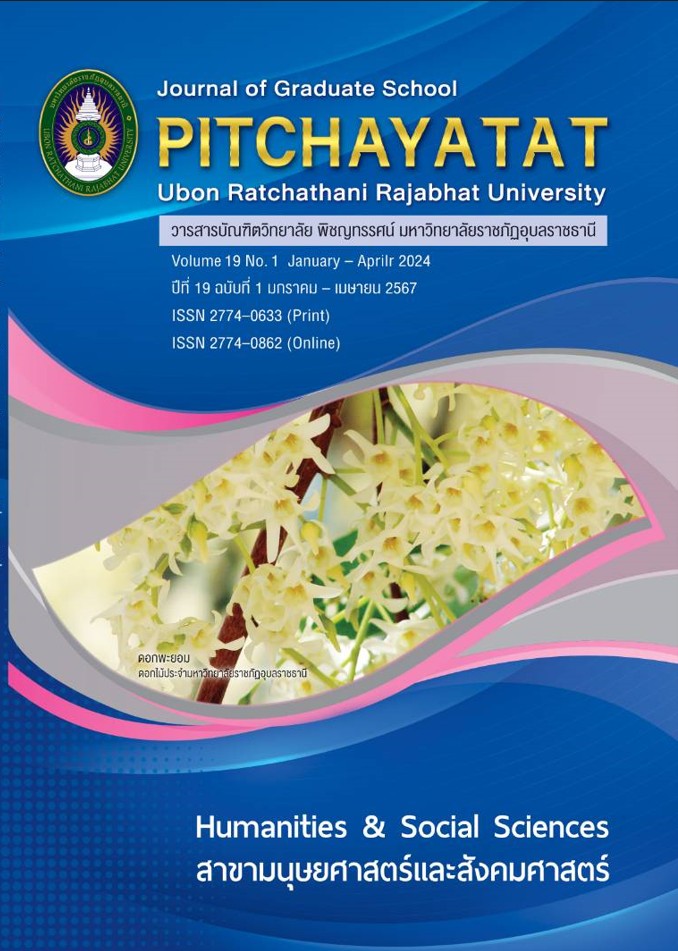การพัฒนาชุมชนปลอดภัยอย่างมีส่วนร่วมพื้นที่เปราะบางชายแดน จังหวัดอุบลราชธานี
คำสำคัญ:
ชุมชน, การมีส่วนร่วม , พื้นที่เปราะบาง , เขตชายแดนบทคัดย่อ
การวิจัยนี้เป็นการวิจัยเชิงปฏิบัติการแบบมีส่วนร่วม เพื่อศึกษาการพัฒนาชุมชนปลอดภัยอย่างมีส่วนร่วมพื้นที่เปราะบางชายแดนจังหวัดอุบลราชธานี จำนวน 7 หน่วยงาน 2 หมู่บ้าน โดยศึกษาจากประชากร จำนวน 200 คน เข้าร่วมกิจกรรมจากผู้นำชุมชน ตัวแทนชุมชน อาสาสมัคร สตรีแม่บ้าน นักเรียน นักศึกษา อาจารย์ ผ่านกิจกรรมค่ายสุขภาพและความปลอดภัยติดต่อกันจำนวน 3 วัน 2 คืน โดยกระบวนการแรงสนับสนุนทางสังคมอย่างมีส่วนร่วม วิเคราะห์ข้อมูลโดยใช้สถิติ ความถี่ ร้อยละ
ผลการวิจัยพบว่า
ผู้นำชุมชน ตัวแทนชุมชน อาสาสมัคร สตรีแม่บ้าน นักเรียน นักศึกษา อาจารย์ เกิดการเรียนรู้เชิงแลกเปลี่ยนกันอย่างมีส่วนร่วม ชุมชนผู้นำชุมชนนักศึกษาได้เข้าถึงปัญหาระดับชุมชนจากการระดมความคิดและการพูดคุยกันสรุปประเด็นปัญหาได้ 3 ประเด็นหลักคือการจัดการขยะในครัวเรือนและชุมชน การขาดการแยกขยะ ห้องน้ำสะอาดตลาดปลอดภัย ทำให้เกิดการปฏิบัติการแก้ไขปัญร่วมกันอย่างมีส่วนร่วมกันเหมาะสมปลอดภัย โดยอาจารย์อบรมเรื่องอนามัยสิ่งแวดล้อมในชุมชน ปราชญ์ชุมชนออกแบบเตาเผาขยะพร้อมสอนนักศึกษา นักเรียนร่วมเรียนรู้เทคนิคการทำงาน อุปกรณ์แยกขยะในชุมชนอย่างง่ายเพื่อความปลอดภัย นักศึกษาช่วยเรื่องห้องน้ำสะอาดตลาดปลอดภัย เกิดการเรียนรู้วิถีพึ่งพากันในชุมชนการเติมอาหารที่บ้านฉันมี การทำบุญตักบาตรเช้า การห่อข้าวต้มมัดโบราณใบมะพร้าวอ่อน และการบายศรีสู่ขวัญรับแขกเยี่ยมบ้านอย่างอบอุ่นเกิดเป็นลูกรักลูกแพง ผลการประเมินความพึงพอใจในกิจกรรมการพัฒนาชุมชนปลอดภัยอย่างมีส่วนร่วมพื้นที่เปราะบางชายแดนจังหวัดอุบลราชธานี ส่วนใหญ่อยู่ที่ระดับมากที่สุดร้อยละ 98.50 และมีคะแนนเฉลี่ย 4.89 (SD.=0.17) สรุปผลการเรียนรู้พัฒนาชุมชนอย่างมีส่วนร่วมและการเข้าถึงรู้จักธรรมชาติชุมชนที่แท้จริงสามารถดึงปราชญ์ผู้รู้ในชุมชนสามารถสร้างศักยภาพชุมชนแก้ปัญหาชุมชนได้อย่างเหมาะสมปลอดภัยในอนาคตได้
เอกสารอ้างอิง
กลุ่มพัฒนาระบบบริหารกรมป่าไม้. คู่มือการบริหารจัดการราชการแบบมีส่วนร่วม. (ออนไลน์) 2550 (อ้างเมื่อ 20 กันยายน 2566). จาก https://forestinfo.forest.go.th/Content/file/ParticipateManagementManual.pdf
ฉัตรชัย ศรีเมืองกาญจนา. การบริหารจัดการด้านความมั่นคงพื้นที่ชายแดนของประเทศไทย.(ออนไลน์) 2564 (อ้างเมื่อ 20 กันยายน 2566). จากhttps://www.parliament.go.th/ewtadmin/ewt/parliament_parcy/ewt_dl_link.php?nid=53901&filename=house2558_2
ชวลิต สละ. การมีส่วนร่วมของชุมชนเพื่อเสนอและแก้ไขปัญหาและวิกฤตปัญหาชุมชนบนเส้นทางรอการพัฒนาสู่ความยั่งยืน. (ออนไลน์) 2566 (อ้างเมื่อ 20 กันยายน 2566). จาก https://www.gotoknow.org/posts/329656
ฐานริณทร์ หาญเกียรติวงศ์. “การมีส่วนร่วมของชุมชนในการแก้ปัญหาหมอกควันในจังหวัดเชียงใหม่,” วารสารเกษมบัณฑิต. 19, ฉบับพิเศษ (มีนาคม 2561): 229-241
เทศบาลตำบลน้ำยืน. ข้อมูลทั่วไปเกี่ยวกับเทศบาลตำบลน้ำยืน อำเภอน้ำยืน จังหวัดอุบลราชธานี. (ออนไลน์) 2566 (อ้างเมื่อ 20 กันยายน 2566). จาก https://namyuen.go.th/index/?page=newarticle02346917
ศศิกาญจน์ ศรีโสภณ. กระบวนการมีส่วนร่วมของประชาชนในการแก้ไขปัญหาที่อยู่อาศัย : กรณีศึกษาชุมชน ศรีวิชัย จังหวัดชัยนาท. งานประชุมวิชาการระดับชาติ มหาวิทยาลัยรังสิต. 26 เมษายน 2562; ปทุมธานี, 2562. หน้า 458-468.
สภาความมั่นคงแห่งชาติ, สำนักงานยุทธศาสตร์ด้านความมั่นคง. แผนบริหารจัดการชายแดนด้านความมั่นคง พ.ศ. 2559-2564. (ออนไลน์) 2559 (อ้างเมื่อ 20 กันยายน 2566). จาก https://www.nsc.go.th/nsc-strategy/
Caitlin, Ryan. 6 Reasons Why Public Participation and Community Engagement Are important. Social Pin Point Logo. (Online) 2019 (cited 20 November 2019) from: https://www.socialpinpoint.com/6-reasons-to-participate-community-engagement/
Wiyaboon, Saowanee. “Community Participation in Local Development Projects,” The Journal of The International Buddhist Studies College. 4, 1 (2018): 18-24.
ดาวน์โหลด
เผยแพร่แล้ว
รูปแบบการอ้างอิง
ฉบับ
ประเภทบทความ
สัญญาอนุญาต
ลิขสิทธิ์ (c) 2024 วารสารบัณฑิตวิทยาลัย พิชญทรรศน์ มหาวิทยาลัยราชภัฏอุบลราชธานี

อนุญาตภายใต้เงื่อนไข Creative Commons Attribution-NonCommercial-NoDerivatives 4.0 International License.
บทความทุกเรื่องได้รับการตรวจความถูกต้องทางวิชาการโดยผู้ทรงคุณวุฒิภายนอกอย่างน้อย 3 คน ความคิดเห็นในวารสารพิชญทรรศน์เป็นความคิดเห็นของผู้นิพนธ์มิใช่ความคิดเห็นของผู้จัดทำ จึงมิใช่ความรับผิดชอบของวารสารพิชญทรรศน์ และบทความในวารสารพิชญทรรศน์สงวนสิทธิ์ตามกฎหมายไทย การจะนำไปเผยแพร่ต้องได้รับอนุญาตเป็นลายลักษณ์อักษรจากกองบรรณาธิการ





